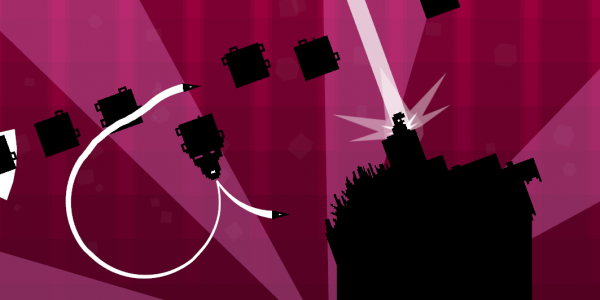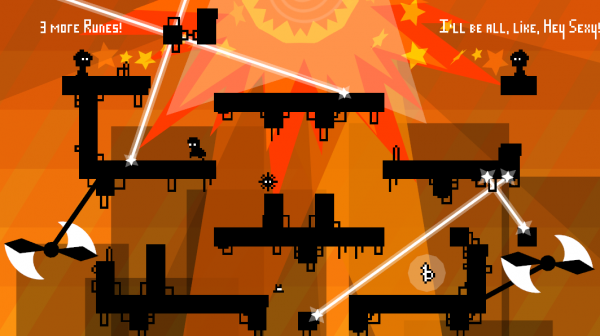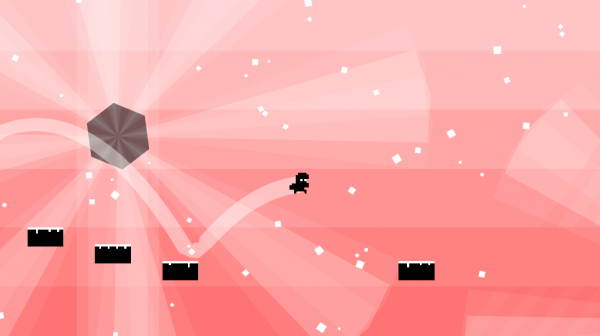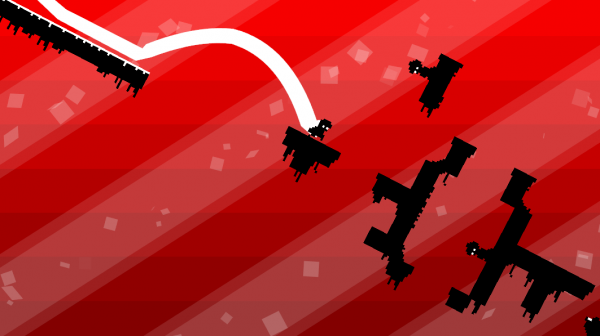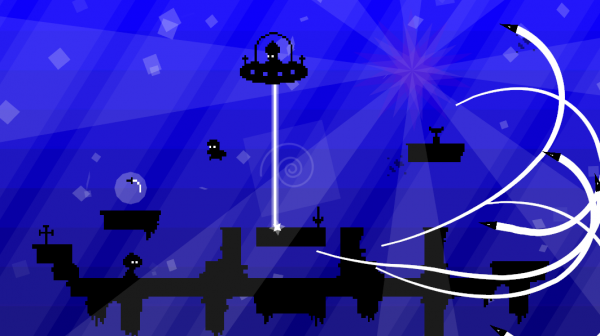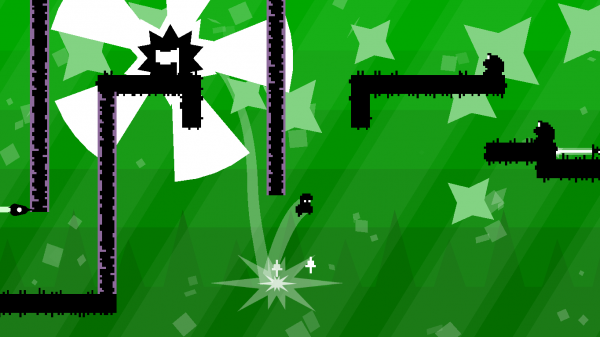Toronto-native Cassie Chui has worked in the games industry professionally for almost a year now. After graduating from school in the Toronto area, where she interned with indie developers, Chui began working on Electronic Super Joy. The game — a 2D platformer centered around rapid movement and pulsating beats — gained attention through trade shows and conventions. The difficulty and quirky graphical styling brought crowds and, eventually, Steam. In early August, Electronic Super Joy had an “Early Access” release, asking supporters to test and give feedback before its proper version was shipped. On August 23, the game closed the early access and version 1.0 was released.
Chui sat down with GamerNode to discuss the game, the industry, and why she didn’t like killing Sonic as a kid. Also, Mario sweatshirts.
GamerNode: How were you brought onto Electronic Super Joy (ESJ)?
Cassie Chui: [Laughs] The story is not really all that remarkable. I had been a friend of [ESJ creator] Michael Todd’s for a little while now. He’s the genius behind the project. And normally he makes all of his games by himself. In true, very indie fashion, he makes his games generally by himself. He does all the programming, all the art. Sometimes he’ll have someone do music for him but he’ll just sorta contract, that sorta thing. So this time around, he decided he needed some help. And I very badly wanted to get out of retail and into game design.
GN: And how long ago was this?
CC: This was October of 2012.
GN: You recently graduated from school; what projects or jobs were you working on before you came onto ESJ?
CC: I got to see what it was like working in a very small indie studio because I was interning with Ryan Crieghton of Untold Entertainment. He’s responsible for Sissy’s Magical Ponycorn Adventure, which is the game he made with his [at the time] five-year-old daughter. It’s adorable. It’s amazing. He let her go wild with it. It’s fantastic. So I managed to get an internship with him and it was really awesome. I did a variety of things. He taught me a little bit of flash, which is fantastic. He taught me a little bit of programming. He taught me some administrative stuff as well. I did play testing stuff for him. I learned how to write a proper bug testing log as well.
GN: What have you been doing on ESJ?
CC: I’m doing level design, so I’m actually building levels for [Todd]. I’m doing some pixel art as well, which is something I’ve never done, either, up until this job. It’s not something that I’ve previously worked on. I have an art background because I had been going to an art school for several years. And I like it a lot better than traditional art in a lot of ways. Pixel art is absolutely something that I picked up while working for Michael.
GN: Why do you like pixel art more than traditional art?
CC: Because in a lot of ways I feel like pixel art is more like constructing than drawing. I feel like I’m building something. Like even when I was at Sheridan College, which is another art school that I’d been to for three years prior to my game design program [at Centennial College in Toronto] they taught us a lot of different art stuff. They taught us traditional drawing and painting and some photography, a little bit of web design. But they also taught us sculpture and stuff. And the sculpture is always something I had a lot more fun with. I feel like I’m a lot more of a tactile artist in that way. I’m also an avid cosplayer; I love making costumes. In a lot of ways, I’m a lot stronger as a constructor than an artist. Being a pixel artist is so much more comfortable because I feel like I’m building something more than I’m drawing something.
GN: How did ESJ begin? How many people are on the team?
CC: We have our sound designer who is primarily a larger part of the team as well – Ryan Roth. He worked with another friend of ours, Alex Martin [known as Droqen]. The two of them worked on Starseed Pilgrim, which got an IGF nomination this year for excellence in design, which is pretty huge. Ryan is our sound designer, he did sound design for Starseed Pilgirm. And Alex did some level design as well.
[Chui later mentioned that JP Stringham also assisted in the creation of ESJ.]
GN: When you were brought on, was it already off the ground?
CC: When I was brought onto the project, it was a prototype. We had, basically, ‘Here are some very plain platforms and a couple of enemies and here is the main character with a jump mechanic.’ And that was it. Then I came on and the growth of this game began to skyrocket. In fact, it was actually meant to be a lot smaller than what it is now. But we ended up looking at it and going, ‘This could be something way more awesome. Let’s make it more awesome. Let’s spend more time on it.’
GN: What games did you look to for inspiration for your own designs?
CC: My favorite classics. I would look to the classic Mario games, even the newer Mario games like New Super Mario Bros. as well, because those level designs are really cool, too. I even looked at games like Kirby. We took a little bit of Mega Man. I took a little bit of Goemon’s Great Adventure as well, which is one of my favorite games of all time and it’s so underrated.
GN: What other games did you enjoy when you were young?
CC: Video games have been in my life since I was really, really little and I’ve always loved them. I was one of those kids growing up, watching the Super Mario cartoon, I had Mario sweatshirts…. Actually, I’m a really strange story because when I was really little all I really had was the Genesis and I didn’t even play. I used to watch my dad play it. Because one day my dad sort of passed me the controller and he’s like, ‘Here, you try it,’ and I tried it and I killed Sonic and I was like, ‘No! I don’t want to kill Sonic.’ And I felt really sad. It was scary to me. I was like, ‘I don’t want to kill Sonic, I like Sonic.’ So I would just watch my dad play. Eventually my next-door neighbors had an N64 and I was old enough to be like, ‘Well, you know, whatever, if I kill Mario it’s not a big deal.’ [Laughs.]
GN: So what you’re saying is you had a connection to Sonic when you were a kid?
CC: Yeah, I liked not hurting him.
GN: But the Super Nintendo and those franchises –
CC: I never had those as a kid.
GN: So it didn’t matter.
CC: I’ve always had a soft spot for Mario because I used to love the Mario cartoons. But as a young kid it was the Genesis that was in my home and I never even played it. It was not until the N64 era when I was an actual, real gamer playing games. So I’m a real odd story that way.
GN: Going back to ESJ, and speaking of 2D platformers, were you guys trying to appeal to a more niche indie crowd with your highly difficult levels?
CC: I consider myself to somewhat of a hardcore gamer, maybe not a hardcore platformer, but a hardcore gamer, in general. And I prefer a more challenging game to something that’s a little bit too easy unless it’s got something else to offer me. For example, my boyfriend and I played through Kirby’s Epic Yarn and I’m like, ‘this game is way too easy but oh god the visuals are so cute and the story is adorable. The co-op its pretty fun. And oh, this game is so cute and happy.’ It makes me happy, but it’s a very easy game. It’s a very, very easy game.
GN: This game is very closely tied to the soundtrack provided by DJ EnV, with musical visuals and a constant momentum to its play style, which supports the electro-pop tunes playing in the background. What made you decide to integrate music so heavily with the platforming?
CC: It’s definitely something that was present from the get-go; when we were building our levels and dealing with the visuals that go with the music, as well as the levels that are going with music. It was something that Michael decided we wanted to do from the start.
GN: The game’s art is full of stark colors: blues, whites, reds, pinks, blacks. What influenced the decision to make it that way?
CC: That’s very much Michael’s art style when it comes to his games, actually. He tends to choose very bright colors against sort of black and white silhouettes. That really is very much his style. With the NPC designs [that I made], I basically took what Michael had in his inherent style and went, ‘Alright, let’s play with that. Let’s do something similar.’
GN: What are the plans for the future? Will you collaborate with Michael again?
CC: In true indie fashion, I don’t know. [Laughs] Ideally, I’d love to continue working with him, but he generally tends to work on his own. I think this is the one game where it was kind of an exception and it’s worked out really well for him; it’s worked out really for us. But, who knows? Michael and I might work on a sequel if the first one works really well for us. If it does really well, if it makes a lot profit, if people really like it, then we might actually do some DLC or even do a sequel. It may or may not happen. We’re not sure. Michael is kind of a tough act to follow in that he’s a true indie. He feels out the moment and goes with it. We’ll see how that happens. If not, I might actually be looking to apply to another really cool indie studio around here. Maybe. We will see. We will see what happens.
GN: So you’re sticking indie? You’re not trying to go with a bigger company?
CC: See the thing is, as a kid growing up, I’d always known I was going to make games for a living. I was like, ‘I’m gonna do it. It’s gonna happen. I’m gonna make games. It’s gonna be awesome.’ And the dream was it’d be really cool to, I don’t know, work for Nintendo. That would be the most badass thing ever. But, I’ve looked at what it’s like to work as an indie and I’ve seen also what it looks like to work in a bigger studio, something triple-A. And I feel like not only would I enjoy being indie more than I would working triple-A, but I’d also be a better fit. Because, personally, I’m not really a specialist. I’m not the kind of person who’s really, really, really good at one thing. I’m sort of good at a lot of things.
GN: I feel like you’re selling yourself short.
CC: Well I mean that’s not totally a horrible thing, especially as an indie.
GN: Are you worried about security at all? Is that something you think about?
CC: It is, it definitely is. But in the end I’m not doing this for the money. It’s good to be able to survive off the money you make but I don’t care if I become a millionaire off of ESJ. That’d be really freakin’ cool, but I’m just happy to be doing what I’m passionate about. As long as I can continue doing that and stay sane and healthy, I’m happy.
GN: It’s about being able to express yourself creatively, which you don’t think is as probable if you went to a bigger studio versus doing it yourself?
CC: Exactly. And that is one of the reasons why, I think, I would prefer to be an indie over being somewhere in a triple-A studio. Because in a triple-A studio you really are just a little cog in a big machine. The concept artists or whatever, the designers, come down to you from above and say, ‘Do this thing.’ And you’re like ‘OK, I’m doing it exactly to your specifications.’ And there you are. And you get paid.




